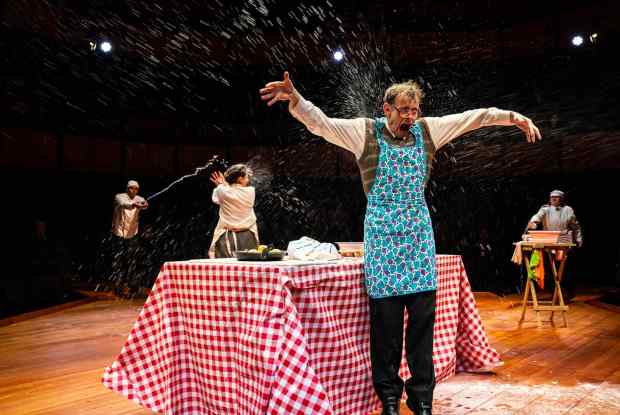Death of a Black Man is a little-known script from the 1970s written by Alfred Fagon who suffered a fatal heart attack in 1986, aged 49. It’s an intriguing but sloppily written play set in 1973 about a pair of black London teenagers who are hustling for cash in the music business and the furniture trade.
Shakie has lucked his way into a Chelsea flat where he makes money flogging African chairs to gullible Americans. His best friend, Stumpie, needs a loan to bring a band of African drummers to the UK. Meanwhile Shakie’s ex-girlfriend, Jackie, has returned from Jamaica to sponge off him and enjoy the high life. Scriptwriting blunders abound. Fagon uses soliloquys to reveal motivation. ‘I wonder who owns this flat,’ says Jackie to herself. When Stumpie arrives, he enters through an unlocked front door. (No one leaves their front door unlocked.) Characters reminisce about the past in order to spoon-feed information to the audience. Clunky telephone calls are used for exposition. ‘Bryan? You’ve got 40 chairs for sale?’
Fagon writes long screeds of meandering dialogue just to keep the action going while a character exits the stage to change costume or to attend a business meeting. Clearly the writer had little theatrical expertise and he created another problem by making his main characters just 18 years old. Performers of that age are rarely skilled or experienced enough to carry a full-length drama. The director, Dawn Walton, has wisely cast older actors in these roles but some of the psychological dynamics are lost.
The play is full of fascinating ideas. Shakie is a charming, greedy cynic who exploits the mystique of Africa by selling ‘ethnic furniture’ (actually made in Yorkshire) to beatnik tourists on the King’s Road. Stumpie accuses him of being a ‘fascist’ who hates black people. But Stumpie has similar faults. He over-romanticises Africa and the spiritual qualities of its musical rhythms and he’s equally keen to line his pockets by selling his drumming band to the world. Jackie, another striking creation, is a smart, sexy adventuress who glides through upper-class society looking for rich men to seduce and milk. But these absorbing characters are marred by feeble plotting and lots of repetitive dialogue.
In the second half, things get worse. The story stagnates entirely and the characters become meaner and nastier. The boys’ business schemes falter and they conspire to pimp Jackie out to an ageing Chelsea millionaire. And Jackie’s character inexplicably changes. Her poise and resourcefulness vanish and she turns into a drippy loser moping around the flat in a stained old nightie. The show ends with a foreseeable surprise that’s depressing to watch. The wrong person dies.
This is a flawed but interesting show that might have worked a lot better. The cast are excellent and the design looks great but at least an hour of waffle should have been cut from the text.
Doctor Who: Time Fracture is a two-hour interactive show about Doctor Who set in a warren of rooms near Bond Street. Visitors are greeted by paramilitary sentries and escorted into a command centre where a fake emergency is under way. Costumed luvvies race around screaming instructions at the crowd and pretending to be scared by an imminent rupture in the space-time continuum. Bossy actors dressed as scientists divide the visitors up into smaller groups and subject them to aggressive and pointless interrogations. This is how interactive theatre works: the audience must entertain the performers and not the other way around. I was with my son, aged 14, who found it all mildly amusing but he was annoyed by my reluctance to engage with, or even to look at, the actors directly. ‘I’m using an SAS survival technique,’ I explained. ‘By avoiding eye contact with your abductors you boost your chances of emerging alive from captivity.’ And it worked. I passed through the ordeal unnoticed.
The show seemed rather short of Doctor Who’s best-known characters and baddies. Only in the final moments did a Dalek finally trundle into view. ‘Exterminate, exterminate,’ it rasped. Having Tasered an actor dressed as a space-age pharisee, it pootled off back to its Dalek kennel. Fans of this overrated televisual tripe will enjoy the show. I found it bombastic, fey and tedious. And I had exactly the same thoughts when Doctor Who was aired on Saturday evenings in the 1970s. The wrestling on ITV was better.
Got something to add? Join the discussion and comment below.
Get 10 issues for just $10
Subscribe to The Spectator Australia today for the next 10 magazine issues, plus full online access, for just $10.
You might disagree with half of it, but you’ll enjoy reading all of it. Try your first month for free, then just $2 a week for the remainder of your first year.














Comments
Don't miss out
Join the conversation with other Spectator Australia readers. Subscribe to leave a comment.
SUBSCRIBEAlready a subscriber? Log in